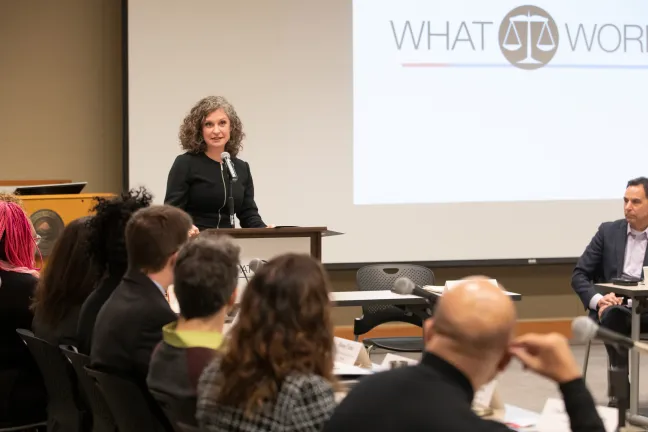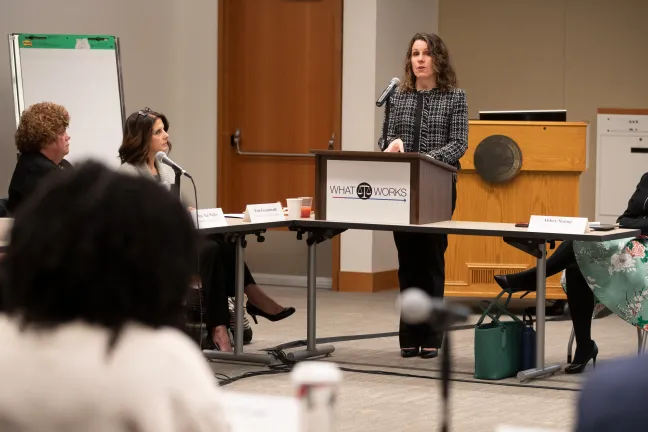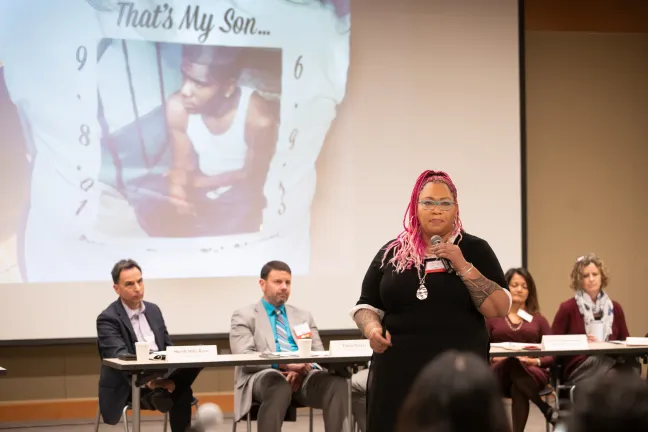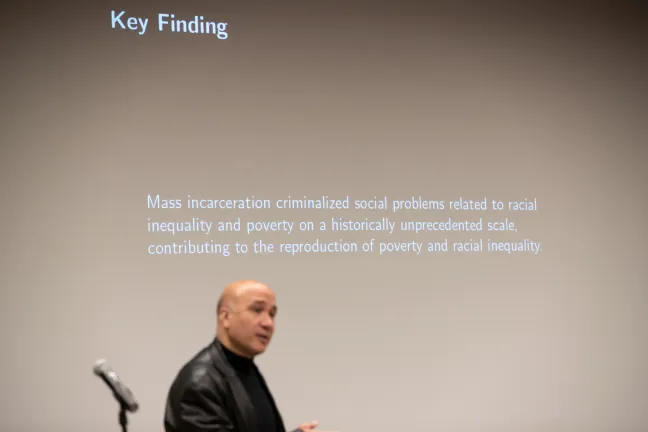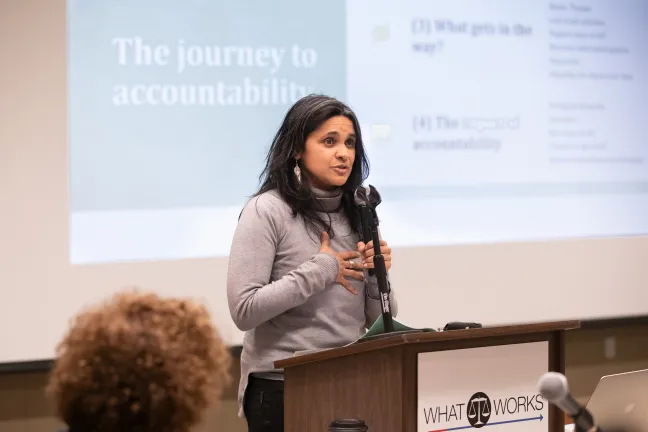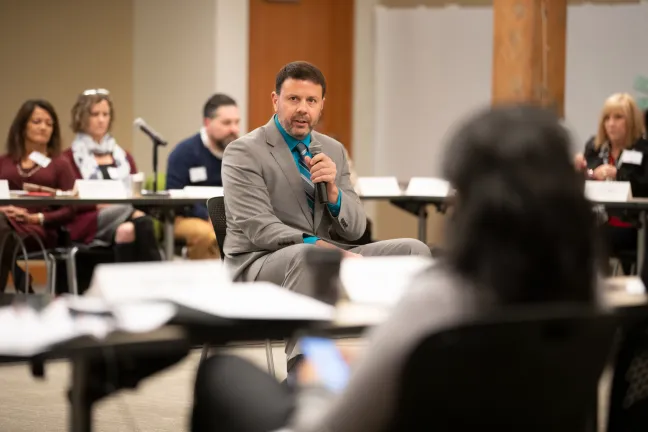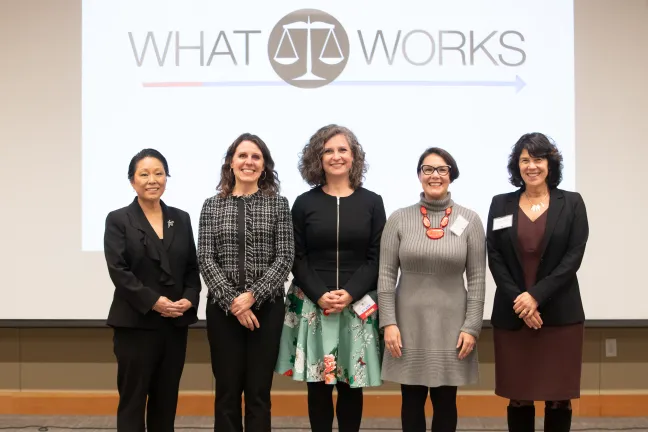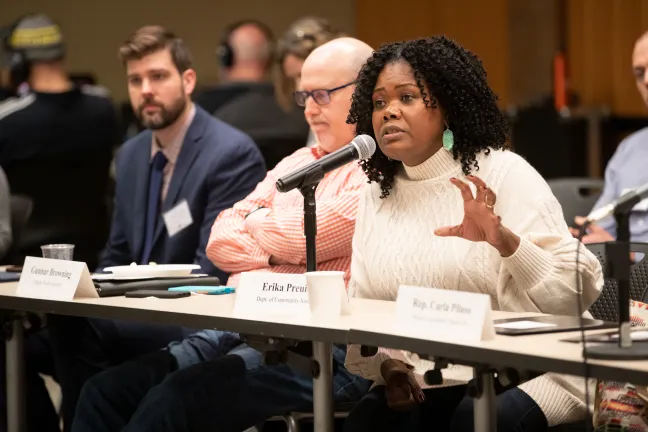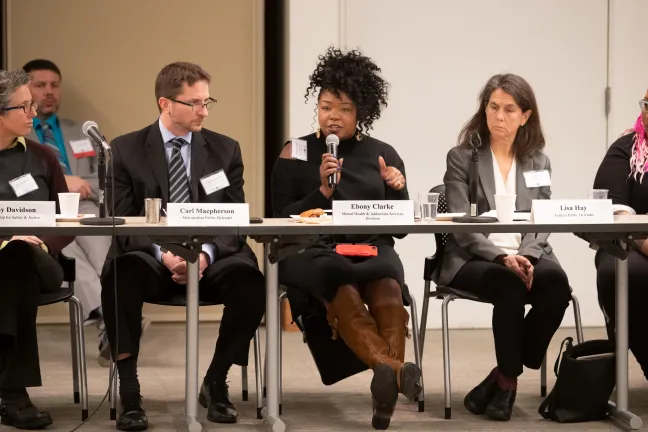More than 50 practitioners, policymakers and experts — including local elected leaders — packed a downtown Portland conference hall Thursday, Jan. 16, for the Multnomah County Local Public Safety Coordinating Council’s What Works (LPSCC) in Public Safety Conference.
The conference — with
Thursday’s meeting helped focus attention on those overlaps and on strategies to improve a system that isn’t adequately equipped to respond to behavior rooted in social problems such as poverty and health disparities.
“We are in crisis,” said Abbey Stamp, Executive Director of the Multnomah County Local Public Safety Coordinating Council.
“There are massive holes in all of our public safety nets and the criminal justice system and the jails end up being the lowest-hanging safety net that people fall through,” she said.
“We need a north star to guide us toward better solutions, and we don’t have that across our systems. We need more voice from people who have been harmed or negatively impacted by others. Often times the criminal justice system looks at people as either a victim or an offender. That does not take into account the human condition that we all harm and we are all harmed.”
Multnomah County Chair Deborah Kafoury, who kicked off the conference, said the ensuing discussion would serve as “a catalyst for a collective vision of public safety.”
The County and its partners should dedicate themselves to building a system that gets people “the right combination of services so they can succeed, while also holding them accountable and keeping the community safe,” Kafoury said.
Getting there will mean building on the work the County has already done despite serious fiscal challenges in the face of limited federal funding and state cutbacks.
Do no more harm
Kimberely Dixon said the public safety system changed her life in unimaginable ways less than a decade ago.
“That night in 2013 started off on a high — playing kickball with my family,” she said. “Then there was the call… that my son had been shot.”
Dixon broke through crime tape to see her son, who’d been killed amid gang violence, only to be met by officers who grabbed and restrained her.
“I said, That’s my son. That’s my son! I carried him for 42 weeks. I carried him into this world and if he’s going to exit, he’s going to exit in my arms,” Dixon said.
Dixon was even kept from seeing her son’s body at the Medical Examiner’s Office. “The only thing I felt like I could control,” she said, “was my drive home.”
Six months later, Dixon’s mother died, too. When her brother — who was incarcerated at 18 — was denied release to come to the funeral, Dixon called corrections officials in extreme grief.
“I want you to see him as a son who just lost his mother,” she implored. They eventually relented.
“I cannot tell you the elation I felt to be able to call my father and tell him he gets to come. That was our Christmas miracle,” she said.
At the conference, Dixon shared photos of the officers and the Washington corrections official who allowed her family to grieve together.
“They unshackled him,” she said. “That’s real.”
Today, Dixon works not only as a life coach and an adjunct professor at Portland Community College, but she also volunteers with the Portland Police Bureau’s Crisis Response Team, working with families who’ve lost loved ones.
“Why do we lose sight, in the criminal justice system,” she said, “that this is still somebody's child. Do no more harm.”
“Hurting people hurt, and a lot of that comes from lack of resources,” she continued.
“So I stand before you as a mother, as a coach. I’m an advocate, but I am first and foremost somebody's child. It starts somewhere. They’re winding up in jail and prison but we need to put those dollars on the front end.”
Racial inequality, poverty and violence
Bruce Western, a professor of Sociology and Social Justice at Bryce University and Co-Director of the Justice Lab at Columbia University, shared several striking statistics about incarceration and supervision in the United States.
In Western European countries, the rate of incarceration is just 100 per 100,000 people.
But in the United States, that rate is almost seven times higher, with some 2.2 million people incarcerated. When including those on parole or probation, the number of people under some kind of correctional supervision is actually 7 million.
That’s not even the most striking number, Western said. It’s the unequal distribution of who’s incarcerated or under correctional supervision — happening over decades and deeply impacting communities of color.
“Mass incarceration criminalized social problems related to racial inequality and poverty on a historically unprecedented scale, contributing to the reproduction of poverty and racial inequality,” Western said.
Western cited findings from his study, “The Boston Reentry Project,” on re-entry to society after incarceration, noting three themes from respondents:
Violence beginning in childhood;
Poor physical health including chronic disease and mental health issues; and
Poverty and material hardship after prison.
Three in five respondents said a family member experienced a substance use disorder while growing up. Two in five said they’d witnessed somebody being killed by age 18. Many people suffered from chronic pain related to drug use. If people were abused as kids, Western said, their health problems were more serious.
“The average income a year after prison was $6,500,” Western said. “Many suffered from debilitating health conditions and no independent housing.”
Western said the struggle to stay healthy and find housing remains “the biggest challenges to social integration after prison.”
“These are the most urgent needs. Incarceration on a massive scale can never be successful in ending violence. The challenge of finding justice involves promoting healing after someone has harmed someone else,” he said. “That means strengthening the intimate ties of healing and families. Good re-entry policy is really simple: It’s healthcare, housing and income support.”
The cycles of trauma
Other speakers at the conference, representing the victims rights community, shared stories of people who’d been offenders and victims.
Mai Fernandez, a former New York City prosecutor who now leads the National Center for Victims of Crime, spoke of a young man named Jose.
“Jose watched his mom kill his dad, because his dad had been beating his mom year after year after year,” she said. “Then Dad is gone and mom goes to prison.”
So what happened to Jose? ”He joined a gang,” Fernandez said.
“Why? Because he has no family,” Fernandez said, with Jose’s mom in prison and his father dead, after years of committing abuse. “The gang members become his family. He also does it for security; because he’s living in a community that’s really unsafe.”
Eventually, when Jose was 18, he was charged with possessing a gun. Now he was a criminal offender, too.
Jose’s story is common. Ninety percent of youth involved with the justice system have at least one of what experts call an “adverse childhood experience.” Many youth in the justice system also have undiagnosed behavioral or physical health disorders, which are often related to childhood trauma and victimization.
But research shows that more than half of crime victims (more than 2.5 million people) — including survivors of violent crime — would prefer a system that invests more in preventive and rehabilitative programs.
“We need to think about more programming,” Fernandez said, “to look at the issue of trauma,”
The conference coincides with the 25th anniversary of the formation of the Local Public Safety Coordinating Council. The body — established by state statute in 1995 — was designed to forge policies and practices that create a more equitable criminal justice system.
The LPSCC supports innovative programs such as the Law Enforcement Assisted Diversion Program or LEAD®, the Multnomah County Justice Reinvestment Program, and the Diane Wade House; programs which have offered opportunities and alternatives for individuals struggling with addiction, mental health, poverty and homelessness— before and after arrest.
But the public safety system is poised for more change, Stamp said.
“The criminal justice system shouldn't respond to most of the social justice problems and public health crises we see,” Stamp said. “It’s the wrong fit, and the return on investment is poor.”
Shifting funds toward health and human services is a better approach.
“My question today is, are you willing to do this to spend time together to figure out how to solve these problems?” Stamp asked.
The conference ended in a collective pledge to begin discussions about next steps.
“It’s really important that we have these kinds of conversations,” Kafoury said, “So that we realize that we can do and we have to do it, because it is the right thing to do.”
Read Racial Justice in Criminal Justice Practice by Abbey Stamp.
Other speakers included Travis Parker, Program Area Director with Policy Research, Inc. and Sonya Shah of The Ahimsa Collective a healing organization that works with people who have committed an act of violence, survivors of violence and their families and law enforcement. Click here to watch full conference.
